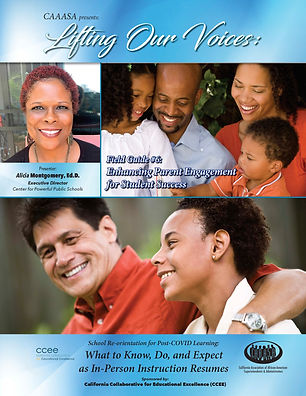
Lifting Our Voices:
Reimagining Schools for Students of Color Amid COVID-19
The California Association of African American Superintendents and Administrators (CAAASA), an organization led by African American educators, has devoted more than 25 years to educational equity and advocacy. Our work disrupts the decades-long trends at the root of California’s stubborn Opportunity Gap for Black and Brown students. We engage teachers, para-educators, principals, district leaders and students and families themselves to implement evidence-based equity interventions that reduce barriers faced by children of color in California schools.
The
Why
We find ourselves at a unique moment in history where we have all undergone a collective trauma from which we are beginning to emerge as a global community, a nation, and a state. Are we going to return to our old way of educating K-12 students? We could not do so even if we tried, because we are not the same people, the same society, nor will we be operating our educational institutions in the same manner as we did prior to March 2020. Since that time, we have lost over half a million US citizens, neighbors, friends, and family members to COVID-19. We have endured over a year of quarantine, confinement to our homes, physical and emotional isolation, as well as economic stress. Going forward, status quo will take on an entirely new definition.
However, we could easily revert to our previous thinking and to the institutional practices at the root of an inequitable educational system in California. That is why CAAASA has recommended that we stop, listen, and re-imagine the delivery of high-quality education for all children in California, not just a few who traditionally have been successful in our schools. Instead, we advocate listening to the experiences and reflections of our students, their parents, their teachers, the paraeducators on campus, principals, district staff, and other members of the educational community.
With each set of experiences from a specific vantage point, we learn of a unique perspective that tells a different story of precisely how the events of the past year have completely changed millions of lives. We persevered through the COVID-19 pandemic, the crisis of racial justice, unemployment levels not seen since the Great Depression. From all of the experiences associated with these events, we struggled to adjust to a “new normal,” from which we grew as a society and as individuals. While there were many lessons learned, some of them extremely harsh on many families, we did survive, and now we hope to thrive having gained knowledge from the experiences or what we call the “lessons learned.”
The
What
Students, parents, teachers, and other members of the educational community have voluntarily quarantined, sheltered-in-place, separated themselves from friends and loved ones in a manner not seen in the United States for over 100 years. With school closures, children have created new digital worlds for themselves with technology playing the dominant role in their lives for 6 to 10 hours a day with few opportunities for face-to-face interactions that our species has enjoyed for several millennia. These experiences, if they are dissected, carefully examined, and thoughtfully considered, can serve as guides for how we can better serve are students in the coming months when students return to their classrooms on campus.
To assist teachers, parents, and students as they return to traditional classroom learning, the Lifting our Voices Field Guides are designed to make that readjustment both possible and successful by capitalizing on the lessons learned in 2020 and 2021.
Parents and teachers have worked more closely together than during any other time in the history of American public education. This experience has reminded us that education truly is a partnership between the home and the school and the more closely parents and educators work in tandem, the greater is the likelihood that each student will be successful academically. Collectively we must commit ourselves not only to closing the achievement gap, but now to also address the impact of 12 months of unfinished instruction and untaught content (not necessarily a “learning loss”) that has impacted millions of our students of color. We believe that meaningful professional learning experiences for educators constitutes one of several ways in which we can confront both contemporary dilemmas simultaneously.
We know where we were and what we learned from our latest experiences. History tells us that we can invest in schools and not “move the needle academically.” However, investing additional time and extra funding into professional development for classroom practitioners typically yields the best return on investment. Now is the time for us to reimagine a more successful educational experience for every student delivered by every teacher in California.
The How
Now is a perfect time for all of us to take time for introspection where we identify, name, and document our experiences of the past 12 months, and harness the power of those lessons learned. Our students, teachers, parents, and families of color will share their distinctly different viewpoints, diverse strengths, and unique attributes all captured through video in the Lifting our Voices Field Guides. We will examine their experiences and the “lessons learned through video and correlated professional learning experiences for educators.
These professional learning materials are designed around clips of leading educational professionals and videotaped interviews with students, teachers, and parents. There are questions that accompany each video segment. If your synchronous professional learning experience will be facilitated by a PD leader, you may wish to develop a series of questions that are strategically carefully aligned with the priorities set by your school. Whether the learning is synchronous or asynchronous, there are a series of questions designed to support professional learning with every video segment.













_Page_01.jpg)
_Page_01.jpg)
_Page_01.jpg)
_Page_01.jpg)




.jpg)